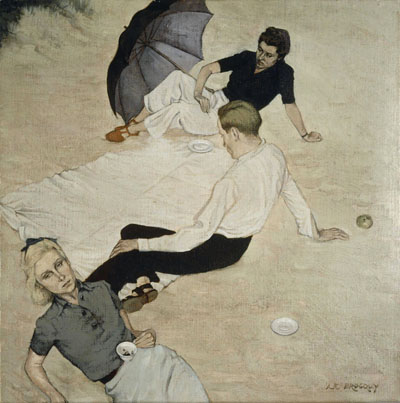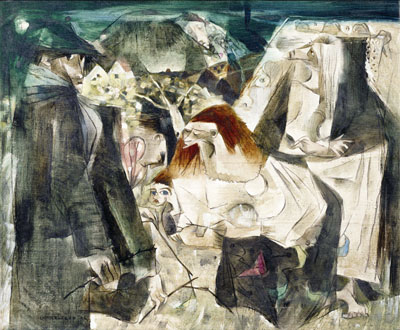LOUIS LE BROCQUY
Obituary
By Ann Cremin
Louis Le Brocquy who died on the 25th April 2012, aged 95, was that « rara avis » - a truly civilised human being. His elegant bearing, silvery blond colouring and his tensile strength made him resemble one of his own paintings. The sharp mind was softened by a courteous attentiveness and endless patience with his many admirers and friends.
 Born in Dublin in 1916, Le Brocquy decided early on not to enter the family business and instead set off on a leisurely and studious tour of Europe, reminiscent of 19th century well-to-do young men. His appetite for learning and his receptive eye led him to look at paintings in all the major museums. He had his first exhibition in London in 1947, as part of a group of like minded artists including Nicholson, Hepworth and Bacon, who remained a lifelong friend. In 1956 he undertook a trip to Spain which was to prove a turning point in his approach to painting. He described it thus : « Each object seemed drowned and absorbed by the sun so that it seemed suspended in a matrix of white light. ».
Born in Dublin in 1916, Le Brocquy decided early on not to enter the family business and instead set off on a leisurely and studious tour of Europe, reminiscent of 19th century well-to-do young men. His appetite for learning and his receptive eye led him to look at paintings in all the major museums. He had his first exhibition in London in 1947, as part of a group of like minded artists including Nicholson, Hepworth and Bacon, who remained a lifelong friend. In 1956 he undertook a trip to Spain which was to prove a turning point in his approach to painting. He described it thus : « Each object seemed drowned and absorbed by the sun so that it seemed suspended in a matrix of white light. ».
He had been working on colourful group paintings, like « The Tinker Family », but henceforth he embarked on a lengthy series of portraits, His favoured subjects were writers and thinkers, among the best known of which are portraits of Yeats, Joyce and of course Beckett.
 Le Brocquy grappled with the academic genre of portraits by producing spectral works, heavily over painted, with swift powerful strokes, from which the heads emerge in an almost ghostly manner. For him « the head was a magic box that held the spirit prisoner » - in attempting to free that spirit, he made many studies for each portrait.
Le Brocquy grappled with the academic genre of portraits by producing spectral works, heavily over painted, with swift powerful strokes, from which the heads emerge in an almost ghostly manner. For him « the head was a magic box that held the spirit prisoner » - in attempting to free that spirit, he made many studies for each portrait.
He and his wife, the painter Anne Madden, lived for many years in the South of France, not far from St Paul de Vence, where the Fondation Maeght included many of the works by the Irish artist in its group shows. In Paris he also showed at the Galerie Jeanne Bucher, who  held an important retrospective five years ago to honour Le Brocquy’s ninetieth birthday. He had a successful exhibition in the Musée d’Art Moderne de la Ville de Paris in 1976, which was well received by the French media. He had been made a Chevalier de la Légion d’Honneur the previous year. He was also the first living artist to be bought by the Irish Museum of Modern Art, where there is a whole floor devoted to his output. Le Brocquy also worked closely with the Aubusson tapestry makers and produced several impressive series of tapestries, chiefly based on Celtic mythology such as the Cuchulain series.
held an important retrospective five years ago to honour Le Brocquy’s ninetieth birthday. He had a successful exhibition in the Musée d’Art Moderne de la Ville de Paris in 1976, which was well received by the French media. He had been made a Chevalier de la Légion d’Honneur the previous year. He was also the first living artist to be bought by the Irish Museum of Modern Art, where there is a whole floor devoted to his output. Le Brocquy also worked closely with the Aubusson tapestry makers and produced several impressive series of tapestries, chiefly based on Celtic mythology such as the Cuchulain series.
Another aspect of Le Brocquy’s talent was accessible to a large public when he illustrated Tom Kinsella’s magnificent translation of the Tain, the epic legends of Irish mythology. Those brush-drawings gave rise to numerous other illustrations, among them the cover of the Crane Bag poetry publication. As a respite from the series of Heads, where the artist delved into the subject’s own mythology and inner consciousness, Louis Le Brocquy also carried out, in the late eighties, a hauntingly beautiful series of flowers, plants, and flying birds. Of that series he told me «I now seem to have returned to an older preoccupation in a shift back to natural things – to growing plants and fruit and goldfish and fan tail pigeons. Perhaps this is simply a temporary release from the rigours of the head and their tragic aspects… a return to a simple state of being, emerging in its own nature, filling out its little volume of reality with the various natural possibilities of its form. »
Louis le Brocquy: www.louislebrocquy.com/ (Official Site)
Louis le Brocquy: Portrait of the artist (Irish Times.com)
Galerie Jeanne Bucher : www.jeanne-bucher.com
Galerie des Portraits Irlandais © 2012 The Irish Eyes - www.irisheyes.fr - contact